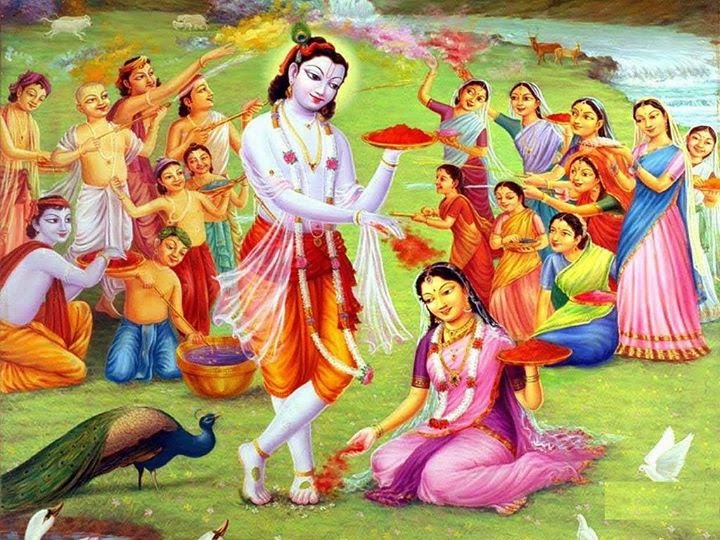Introduction
- What is Holi? Holi, the “Festival of Colors,” is one of India’s most joyful festivals, celebrated worldwide by people of all ages and backgrounds. Known for its colorful powder, playful spirit, and rich cultural history, Holi signifies the arrival of spring, the triumph of good over evil, and the importance of unity.
- Why Holi Matters Today: Explore how Holi’s traditions resonate with themes of joy, renewal, and togetherness, making it a cherished celebration.
1. The Origins and Mythology of Holi

- Ancient Roots of Holi: Holi dates back centuries, mentioned in ancient Hindu texts like the Puranas. This section explains how Holi was originally celebrated as a spring festival.
- The Legend of Prahlada and Holika: One of the most famous stories behind Holi is the victory of Prahlada over his aunt Holika, representing the triumph of good over evil. This story is tied to the tradition of Holika Dahan, where bonfires are lit to symbolize burning away negativity.
- Krishna and Radha’s Connection to Holi: Holi is also associated with the playful, colorful interactions between the Hindu god Krishna and his beloved Radha, highlighting love and mischief.
2. Key Traditions and Customs of Holi
- Holika Dahan (The Bonfire Night): On the eve of Holi, communities gather to light bonfires symbolizing the victory over evil. This section can describe the ritual, its significance, and traditional prayers.
- Playing with Colors: The most iconic aspect of Holi is playing with colors—people throw vibrant powders (gulal) on each other, representing joy, forgiveness, and the coming together of all communities.
- Traditional Food and Sweets: Dishes like gujiya, malpua, thandai, and puran poli make Holi a culinary delight. Include recipes or descriptions to engage readers who are interested in food.
- Music and Dance: The celebration wouldn’t be complete without traditional Holi music and dances, including folk songs and Bollywood tunes that add to the festive spirit.
3. Holi Preparations: Before, During, and After

- Pre-Holi Preparations: Communities clean and decorate their homes, make arrangements for Holika Dahan, prepare colors, and prepare special sweets.
- Celebrating Holi with Friends and Family: Tips for playing with colors safely, respecting traditions, and including everyone in the celebration.
- Post-Holi Cleanup and Reflection: After the festivities, families enjoy quieter moments with relatives, reflecting on the holiday’s message of renewal.
4. Regional Variations of Holi in India
- Lathmar Holi in Barsana and Nandgaon: In these towns, Holi is celebrated uniquely with women playfully “hitting” men with sticks, creating a lively and entertaining tradition.
- Royal Holi in Rajasthan: Rajasthan’s palaces and forts provide a majestic setting for Holi, where locals and tourists celebrate with cultural performances and special events.
- Holi in Vrindavan and Mathura: Known as the birthplace of Lord Krishna, these towns celebrate Holi with religious fervor, including temple events, flower showers, and music.
- Shigmo Festival in Goa: Goa celebrates a form of Holi known as Shigmo, which involves processions, folk performances, and communal gatherings.
- Basant Utsav in West Bengal: Also known as Dol Purnima, Holi is celebrated in West Bengal with Rabindranath Tagore’s influence, emphasizing cultural performances and yellow attire.
5. Popular Holi Festivals Around the World
- Celebrations in the United States and Canada: Many Indian communities host large-scale Holi events featuring color play, traditional food, and Bollywood music.
- Holi in the UK and Europe: Holi has gained popularity in major cities like London and Berlin, where people from diverse backgrounds come together to celebrate.
- Australia and New Zealand: The Holi Festival of Colors events in cities like Sydney and Auckland draw massive crowds, celebrating diversity and unity.
- Holi in Nepal: Celebrated as Fagu Purnima, Holi is a national holiday in Nepal, where locals play with colors and participate in temple rituals.
6. Holi’s Cultural and Spiritual Significance
- Symbolism of Colors: Colors represent different aspects of life and emotions, such as red for love, green for new beginnings, and yellow for happiness.
- Holi as a Festival of Unity and Reconciliation: Holi brings people of all backgrounds together, promoting forgiveness and new friendships.
- The Arrival of Spring: Holi marks the end of winter and the arrival of spring, symbolizing new life, growth, and rejuvenation.
7. Eco-Friendly and Safe Holi Practices
- Organic and Natural Colors: Encourage readers to use plant-based colors made from flowers, turmeric, and other natural ingredients.
- Avoiding Water Waste: Playing with dry colors or limiting water usage can help make Holi environmentally friendly.
- Skin and Hair Protection: Offer tips for applying oil or lotion to the skin before playing with colors to prevent irritation.
- Animal Welfare: Encourage readers to protect pets and stray animals from harmful colors and festivities that might disturb them.
8. How to Host a Memorable Holi Party
- Invitations and Décor: Tips for creating colorful invitations and decorating with traditional Holi colors and flowers.
- Traditional Food and Drinks: Offer easy recipes for classic Holi dishes like gujiya, pakoras, and the festive drink thandai.
- Color Station Setup: Ideas for setting up a color station with safe, eco-friendly powders and water balloons.
- Games and Activities: Host games like tug-of-war, dance competitions, and other playful activities to keep the energy high.
9. Holi and Pop Culture: Influence on Music, Film, and Art
- Holi Songs and Bollywood: Bollywood has a tradition of creating memorable Holi songs, from “Rang Barse” to “Balam Pichkari,” that capture the essence of the festival.
- Art and Literature Inspired by Holi: Holi’s vibrant colors have inspired painters, poets, and writers to capture the festival’s beauty and spirit.
- Social Media and Modern Representation: Holi is a popular theme on platforms like Instagram and YouTube, where people share colorful, joyful moments.
10. Holi Festivals You Can’t Miss in India
- Braj Ki Holi in Mathura and Vrindavan: Known for its religious importance, this celebration includes temple rituals, Krishna-themed events, and community gatherings.
- Jaipur Holi Festival: The royal ambiance in Jaipur, combined with traditional folk performances, makes it a picturesque Holi destination.
- Hampi Holi: Known for its ancient temples and scenic views, Hampi is a unique spot for celebrating Holi with a serene twist.
Conclusion
- Celebrating Holi’s Message of Joy and Renewal: Holi is more than just a festival of colors; it’s a celebration of life, love, and new beginnings. This final section can reflect on how Holi encourages us to live joyfully, forgive others, and embrace the beauty of change.

Leave a Reply